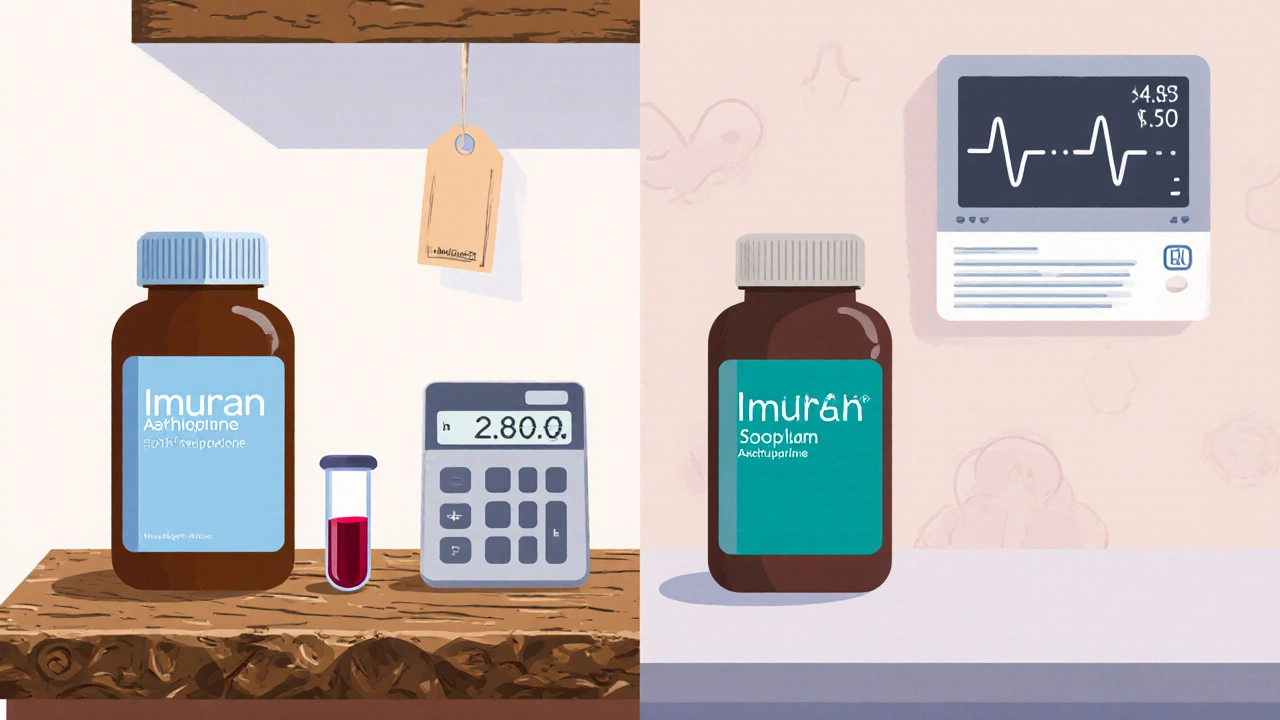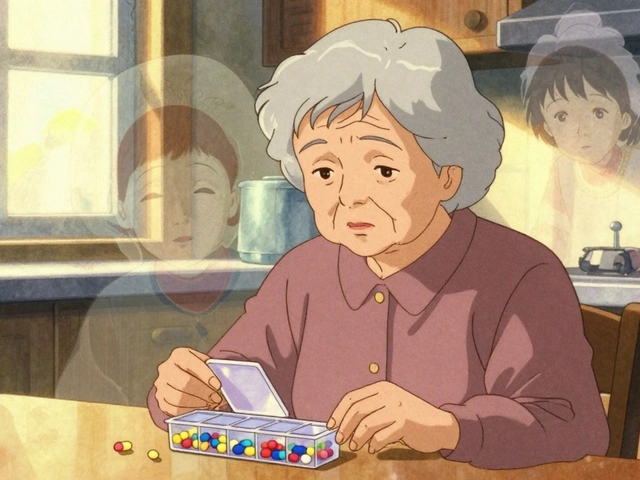Immunosuppressant Drug Comparison Tool
Select Two Drugs to Compare
Quick Takeaways
- Imuran (Azathioprine) is a classic oral immunosuppressant used for autoimmune disorders and organ transplant maintenance.
- Mycophenolate mofetil and Methotrexate are the most common modern alternatives, offering different safety profiles.
- Choosing the right drug hinges on disease type, kidney function, infection risk, and how closely you can stick to lab monitoring.
- Cost varies widely - generic Azathioprine is cheap, while newer agents can be several times more expensive.
- All agents need regular blood work; skipping monitoring raises the chance of serious bone‑marrow suppression.
What Is Imuran?
When you see the name Imuran Azathioprine is an oral immunosuppressant that belongs to the purine‑analogue class. Approved in the 1960s, it’s been a workhorse for conditions like rheumatoid arthritis, inflammatory bowel disease, and post‑transplant prophylaxis.
How Imuran Works
Imuran inhibits purine synthesis in rapidly dividing lymphocytes, which dampens the immune response. The active metabolite, 6‑mercaptopurine (6‑MP), gets incorporated into DNA and RNA, leading to cell cycle arrest.
Typical Users and Dosing
Doctors prescribe Imuran for:
- Autoimmune diseases (e.g., lupus, ulcerative colitis)
- Kidney, liver, or heart transplant recipients
- Some dermatological conditions like pemphigus vulgaris
Starting doses range from 1-2mg/kg daily, adjusted based on blood counts and TPMT enzyme activity.
Key Alternatives to Imuran
Several drugs can replace or complement Imuran, each with its own pros and cons.
Mycophenolate Mofetil
Mycophenolate mofetil is a reversible inhibitor of inosine‑5ʹ‑monophosphate dehydrogenase. It blocks guanine nucleotide synthesis, curbing T‑ and B‑cell proliferation. Commonly branded as CellCept, it’s favored in kidney transplantation and lupus nephritis.
Methotrexate
Methotrexate is a folate antagonist that interferes with DNA synthesis. Low‑dose regimens are a mainstay for rheumatoid arthritis and psoriasis, while high‑dose protocols treat certain cancers.
Cyclosporine
Cyclosporine is a calcineurin inhibitor that impedes interleukin‑2 production. It’s potent for organ‑transplant rejection prophylaxis but requires careful blood‑level monitoring.
6‑Mercaptopurine (6‑MP)
6‑Mercaptopurine is the direct active metabolite of Azathioprine. Some clinicians use it as a second‑line agent for inflammatory bowel disease when Azathioprine isn’t tolerated.
Leflunomide
Leflunomide inhibits dihydroorotate dehydrogenase, reducing pyrimidine synthesis. It’s an oral option for rheumatoid arthritis with a long half‑life.
Tacrolimus
Tacrolimus another calcineurin inhibitor, more potent than Cyclosporine. Used mainly in transplant protocols and severe atopic dermatitis.
Biologic Agents (e.g., Adalimumab)
Adalimumab is a monoclonal antibody that neutralizes tumor necrosis factor‑α (TNF‑α). While not a classic small‑molecule immunosuppressant, biologics are often considered when oral agents fail.

Side‑by‑Side Comparison
| Drug | Mechanism | Typical Indications | Oral Bioavailability | Half‑life | Monitoring Needs | Common Side Effects | Approx. Monthly Cost (USD) |
|---|---|---|---|---|---|---|---|
| Imuran (Azathioprine) | Purine‑analogue; inhibits DNA synthesis | Rheumatoid arthritis, IBD, transplant | ≈85% | 4-6hours (active metabolites longer) | CBC, liver enzymes, TPMT activity | Leukopenia, hepatotoxicity, GI upset | $10‑$30 |
| Mycophenolate mofetil | Inhibits IMP dehydrogenase | Kidney transplant, lupus nephritis | ≈95% | 16-18hours | CBC, renal function | GI distress, anemia, infection risk | $100‑$300 |
| Methotrexate | Folate antagonist | Rheumatoid arthritis, psoriasis | ≈70% | 3-10hours | Liver enzymes, renal function, CBC | Hepatotoxicity, mucositis, lung toxicity | $5‑$20 |
| Cyclosporine | Calcineurin inhibitor | Transplant, severe psoriasis | ≈30% | 6-12hours | Blood trough levels, renal function | Nephrotoxicity, hypertension, gum hyperplasia | $150‑$400 |
| 6‑Mercaptopurine | Active metabolite of Azathioprine | IBD (maintenance) | ≈85% | 4-8hours | CBC, TPMT activity | Myelosuppression, hepatotoxicity | $15‑$35 |
| Leflunomide | Dihydroorotate dehydrogenase inhibitor | Rheumatoid arthritis | ≈80% | 15days (active metabolite) | Liver enzymes, CBC | Hepatotoxicity, alopecia, hypertension | $50‑$120 |
| Tacrolimus | Calcineurin inhibitor (more potent) | Transplant, atopic dermatitis | ≈25% | 12hours | Blood trough levels, nephrotoxicity | Nephrotoxicity, neurotoxicity, hyperglycemia | $200‑$500 |
| Adalimumab (Biologic) | Anti‑TNF‑α monoclonal antibody | RA, Crohn’s disease, psoriasis | Injectable (subcutaneous) | 2‑weeks (half‑life) | Screen for TB, hepatitis; periodic labs | Injection site reactions, infection risk | $1500‑$2500 |
Pros & Cons of Each Option
Imuran (Azathioprine) - cheap and oral, but needs TPMT testing and frequent blood counts to avoid bone‑marrow suppression.
Mycophenolate - strong efficacy for transplant, but higher price and GI side effects.
Methotrexate - inexpensive and well‑studied for arthritis, yet hepatotoxicity can limit long‑term use.
Cyclosporine - powerful for acute rejection, but nephrotoxicity demands tight monitoring.
6‑MP - similar to Azathioprine but sometimes better tolerated in IBD; still requires TPMT testing.
Leflunomide - oral convenience for RA, but a very long washout period if you need to stop.
Tacrolimus - most potent calcineurin inhibitor, ideal for high‑risk transplants, but cost and neuro‑side effects can be tricky.
Adalimumab - targeted biologic, works when small molecules fail, but injections and high cost limit accessibility.
How to Choose the Right Immunosuppressant
- Identify the primary disease. Transplant protocols often dictate a calcineurin inhibitor plus an antiproliferative like Mycophenolate. Autoimmune arthritis leans toward Methotrexate or Leflunomide.
- Check organ function. Impaired kidneys favor drugs with lower renal clearance (e.g., Methotrexate dose‑adjusted, Mycophenolate caution).
- Assess infection risk. High infection risk patients may avoid potent agents that cause deep leukopenia (Azathioprine, Mycophenolate).
- Consider monitoring feasibility. If you can’t get weekly CBCs, a drug with less frequent labs (e.g., Leflunomide) may be safer.
- Factor in cost and insurance. Generic Azathioprine and Methotrexate are budget‑friendly; biologics often need prior‑authorisation.
Talking with your rheumatologist or transplant specialist about these factors will help you land on the most balanced choice.
Common Side Effects & What to Watch For
All immunosuppressants share a core risk: reduced ability to fight infections. Specific red flags differ:
- Azathioprine - sudden drop in white blood cells, yellowing of skin (liver), severe nausea.
- Mycophenolate - persistent diarrhea, anemia, opportunistic infections like BK virus.
- Methotrexate - liver enzyme rise, mouth ulcers, shortness of breath (rare lung toxicity).
- Cyclosporine - rising creatinine, high blood pressure, gum overgrowth.
- Leflunomide - elevated liver enzymes, high blood pressure, hair thinning.
- Tacrolimus - tremor, high blood sugar, kidney function decline.
- Adalimumab - injection site redness, reactivation of latent TB.
Regular labs, symptom tracking, and prompt reporting to your clinician are the best defense.
Frequently Asked Questions
Can I switch from Azathioprine to Mycophenolate without a washout period?
Generally a short overlap of 48‑72hours is safe, but your doctor will check blood counts and kidney function before making the switch.
Why is TPMT testing required before starting Azathioprine?
TPMT (thiopurine methyltransferase) activity predicts how fast your body converts Azathioprine into its active form. Low activity raises the risk of severe bone‑marrow suppression, so dosing is adjusted or the drug is avoided.
Is Methotrexate safe for someone with mild liver disease?
Caution is advised. Low‑dose weekly regimens can be used with close monitoring of liver enzymes, but many clinicians prefer alternatives like Leflunomide if liver enzymes are already elevated.
How often should I get blood work while on Cyclosporine?
Initially weekly for the first month, then every 2-4weeks once stable. Creatinine, electrolytes, and blood pressure are checked each visit.
Can biologics replace Azathioprine for ulcerative colitis?
Yes, agents like Infliximab or Adalimumab are approved for moderate‑to‑severe ulcerative colitis and often work when oral immunosuppressants fail, but they require infusion or injection and are pricier.
Next Steps If You’re Considering a Switch
1. Book an appointment with your specialist and bring a list of current meds. 2. Ask for TPMT testing if Azathioprine is on the table. 3. Review your insurance formulary - generic Azathioprine may be covered, while biologics often need prior authorization. 4. Set up a lab schedule: CBC, liver, kidney, and drug‑specific levels. 5. Keep a symptom diary for the first 4‑6weeks after any change.
Changing immunosuppressants is not a DIY project, but being armed with clear facts makes the conversation with your doctor much smoother.







Tyler Dean
28 September, 2025 10:11 AMThe pharma lobby hides the true danger of these cheap immunosuppressants behind glossy cost charts.
Susan Rose
5 October, 2025 08:51 AMIn many Asian countries azathioprine is often paired with traditional herbal formulas, which can modestly reduce GI upset, whereas in the U.S. patients tend to rely solely on the drug and end up with more side‑effects. It's a reminder that cultural context matters when managing immunosuppression.
Eve Perron
12 October, 2025 07:31 AMThiopurine methyltransferase (TPMT) testing is a cornerstone before initiating azathioprine therapy, as it predicts the patient’s capacity to metabolize the drug into its active metabolites; low TPMT activity markedly increases the risk of myelosuppression, potentially leading to life‑threatening leukopenia. The test is a simple blood assay that quantifies enzyme activity, giving results in units per milliliter of red blood cells; values are typically categorized as normal, intermediate, or deficient. Patients with normal TPMT activity can usually start at the standard dose of 1–2 mg/kg per day, whereas those with intermediate activity should receive a reduced dose, often 30–70 % of the conventional amount, to mitigate toxicity. In the case of TPMT deficiency, clinicians generally avoid azathioprine entirely and opt for alternative agents such as mycophenolate or methotrexate. Moreover, the test should be repeated if the patient experiences unexpected cytopenias, as concomitant medications or viral infections can transiently affect TPMT function. Insurance coverage for TPMT testing has improved over the past decade, yet some plans still require prior authorization, making pre‑treatment counseling essential. It is also prudent to re‑check complete blood counts weekly for the first month, because even with normal TPMT activity, idiosyncratic reactions can occur. Patients should be educated to report any signs of infection, bruising, or unusual fatigue promptly, as these may herald early bone‑marrow suppression. In clinical practice, the integration of TPMT results with other risk factors-such as age, renal function, and concomitant use of allopurinol-creates a personalized dosing strategy that balances efficacy with safety. For patients who cannot undergo TPMT testing, a cautious start at a low dose with close laboratory monitoring is an alternative, though it carries a higher uncertainty. Additionally, newer pharmacogenomic panels sometimes include NUDT15 genotyping, which further refines risk assessment, particularly in Asian populations where NUDT15 variants are more prevalent. The cost of TPMT testing is modest compared to the potential expense of managing severe leukopenia, hospitalization, and a possible need for growth factor support. Clinicians should document the TPMT result in the electronic health record to ensure that future prescribers are aware of the patient’s metabolic profile. Finally, patient adherence to the monitoring schedule is critical; missed labs can delay the detection of toxicity and compromise treatment outcomes.
Josephine Bonaparte
18 October, 2025 02:24 AMGreat rundown! That TPMT primer will definitely help folks dodge the nasty blood‑count drops.
Meghan Cardwell
23 October, 2025 21:17 PMWhen you juxtapose azathioprine’s purine‑analogue mechanism with mycophenolate’s IMP dehydrogenase blockade, you’re essentially weighing a broad‑spectrum antimetabolite against a selective guanosine synthesis inhibitor; the former offers a wider immunosuppressive canvas but at the expense of hematologic volatility, whereas the latter delivers a tighter therapeutic index but demands vigilant renal surveillance.
stephen henson
28 October, 2025 11:24 AMNice breakdown, Meghan! 👍 Just remember to pair the drug choice with the patient’s kidney function and budget constraints. 💊
Manno Colburn
31 October, 2025 22:44 PMWell i guess u r right, steve, but i cant help noticing that many peopl forget how the cost factor can actually drive a patient to skimp on labs, which in turn makes the whole whole immunosuppressive regimen a house of cards; i mean, you can have the perfect pharmacology on paper but if the insurance won’t cover the drug or the side effect management, the patient ends up in a vicious cycle of under‑dosing and flare‑ups, and that’s not just a medical issue, it’s a socioeconomic disaster; maybe we should push for more transparent pricing and better patient education so that the whole system doesn’t collapse under its own weight.
Chloe Ingham
5 November, 2025 13:51 PMImagine the terror of watching your blood work plummet while the world around you pretends everything’s fine-each drop in white cells feels like a silent scream echoing through the halls of the clinic.
Mildred Farfán
9 November, 2025 01:11 AMOh, absolutely, because who wouldn’t love paying $2,000 a month for a drug that makes you feel like you’re starring in a medical thriller? The suspense is just priceless.
Danielle Flemming
12 November, 2025 12:31 PMStay hopeful, everyone! Even if the cost seems steep, many foundations offer assistance programs, and with the right monitoring you can keep those flares at bay and enjoy a brighter, healthier tomorrow.
Anna Österlund
15 November, 2025 23:51 PMEnough with the wishful thinking-if you don’t demand lower prices now, the system will keep throwing you moon‑rock‑level bills, and no amount of optimism will fix that broken economics.
xie teresa
19 November, 2025 11:11 AMI hear your frustration, Anna, and I agree that systemic change is urgent; at the same time, let’s keep supporting each other with practical resources and shared knowledge while we push for policy reform.